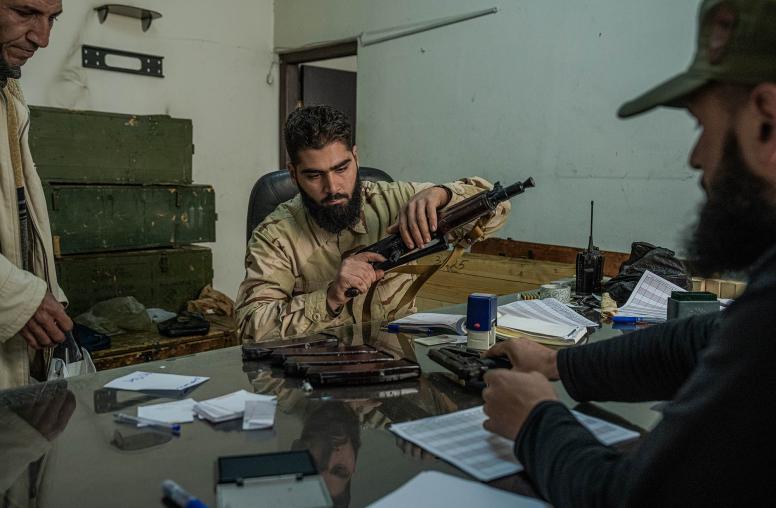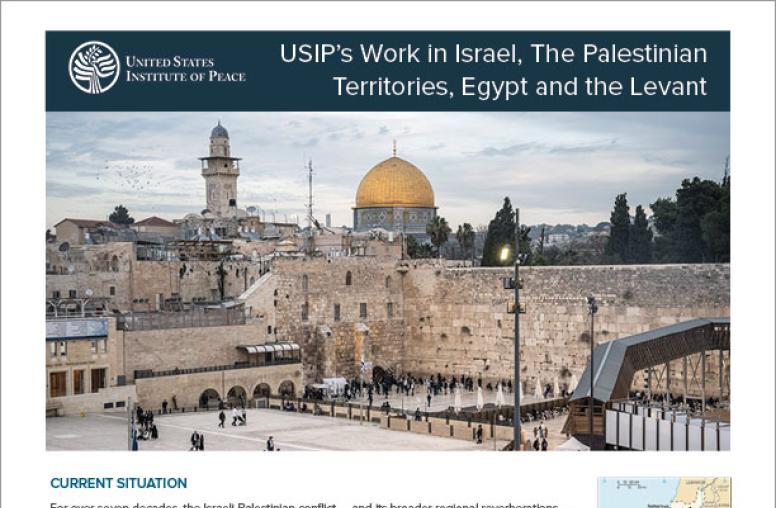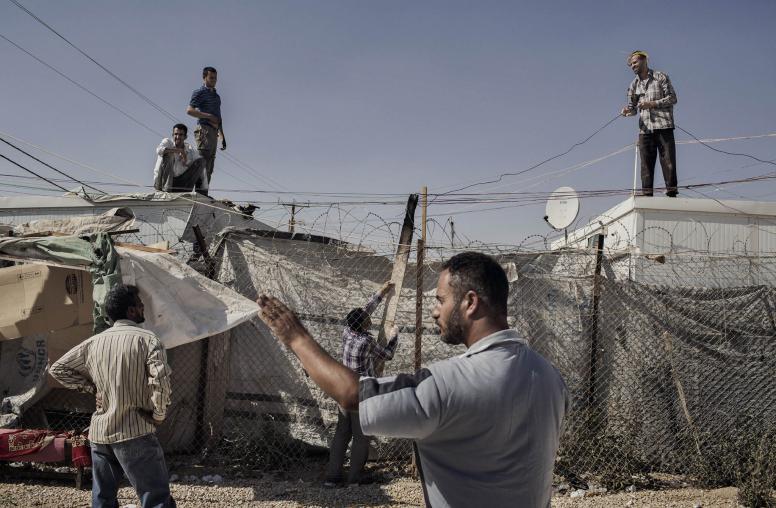Update Aug. 15, 2016: Rescue worker Khaled Harah, who spoke at USIP in this 2014 discussion, died in the kind of airstrike he and others knew too well. See news report here.
The day started with seven hours of digging through rubble to free three families from a building hit by a barrel bomb. Just as the workers thought they were finished, a frantic mother rushed up to them, crying and pleading to please help find her missing baby too, a child just 10 days old. The resulting 16-hour day of painstakingly clearing pieces of collapsed ceilings and walls typifies the daily routine for a group of Syrian rescue workers who told their stories at USIP recently.

"Now it's our daily life," said Raed Saleh, the head of the Syrian Civil Defense corps in Idlib, a rebel-held city in Syria's north. "Like when you wake up in the morning and [drink] your Nescafe, for us, we wake up and wait for the airstrike."
The rescue corps, formed for the first time in 2013, is made up of organized volunteers in the opposition-controlled parts of Syria, including Aleppo and Idlib provinces, who provide emergency medical assistance and search-and-rescue services. The group includes women, and it shuns religious or sectarian distinctions when it comes to deciding who can join the corps or who will be rescued.
The volunteers have recorded thousands of lives saved. Twenty-six workers were killed in the course of four months, according to the web site of a group trying to raise money and awareness for their work, the Syria Campaign. The volunteers often are ill-equipped and when they receive aid from other governments to buy equipment, the funding might not include money for routine maintenance such as fuel and spare parts for the machinery.
The first formal trainings for rescue workers took place outside Syria, in southern Turkey in June 2013. Since then, Saleh and his team have opened three training centers in Syria, two in Idlib and one in Aleppo. Today, they have almost 1,050 volunteers working out of the centers around the country: 17 centers in Aleppo, 17 in Idlib, 9 in Hama, and 6 in the Latakia countryside.
Despite this rapid expansion in the past year, the corps' task is daunting in the face of the air power commanded by the regime of Syrian President Bashar al-Assad. In the Sept. 30 panel discussion at USIP that was also webcast, Saleh explained that the average number of airstrikes per day in Idlib is 15. Sometimes there are more than 100 in a day.
Need for equipment, supplies
The Syrian Civil Defense corps is unarmed and impartial, and the members operate on values of "solidarity, humanity and impartiality," based on the tenets of the Switzerland-based International Civil Defense Organization and drawing on some of the principles outlined in the Geneva Convention.
"We don't have advanced equipment," said Khaled Harah, a member of the Syrian Civil Defense in Aleppo City, who told the story of the trapped baby. "We don't have search cameras or sound sensors to detect where are the people under the rubble. So we use very light and basic materials … If we have proper equipment, we will be able to rescue more people."
While in Washington and New York, Saleh, Harah, and their translator and program manager Farouq Habib are conducting as many meetings as possible to raise awareness about what they are doing and their need for supplies and equipment.
"We want accreditation from the United Nations to be a humanitarian organization working to help civilians," said Saleh, who before the war was a businessman selling electrical equipment. He explained the group's vision to form special volunteer Syrian search-and-rescue teams that can also work in other countries on humanitarian relief missions.
U.S. government-funded projects have provided about $6 million of vehicles and trucks so far and the group has been promised an additional $4.5 million in vehicles and other equipment, Saleh said. But that may not be enough.
"We informed officials that we need funds for operating expenses," he said. "Heavy equipment needs fuel [and] spare parts and we don't have other sources of income and cannot cover operating expenses."
The rescue workers also lack resources to provide psychosocial support to survivors, much less themselves, as they move from bombing to bombing to save lives.
U.S. airstrikes on Syria
When asked about the recent American airstrikes on Syria targeting the militant group known as ISIS (the Islamic State of Iraq and Sham, or ISIL by an alternative name) and another identified as the Khorasan group, Saleh said the U.S. actions increased the suffering of Syrian civilians even while giving them hope.
"People had some hope that, if the U.S. and the coalition started targeting ISIS, [U.S. forces]might go further and target the regime later on," Saleh said.
But the airstrikes hit one of the most important grain storage sites in the Aleppo provincial town of Manbij as well as some oil fields, raising prices of these commodities for civilians, Saleh said. The grain store that was destroyed was the source of grain for millions of Syrians, he said. A barrel of oil that cost 10,000 Syrian pounds before the strikes immediately rose to 45,000 pounds and became increasingly difficult to find, he said. There is fear of further airstrikes on critical supply stores.
Dr. Samer Attar, an orthopedic surgeon at Northwestern University's Feinberg School of Medicine in Chicago, also spoke at the USIP event about his experiences as a surgeon working in Syria as part of the Syrian American Medical Society. Attar completed his second, two-week trip to Aleppo in August of this year, and he highlighted the challenges for medical professionals operating in a war zone.
His presentation included photos he had taken during his time in Syria of field hospitals resembling bunkers with windows blocked by sandbags and X-rays of shrapnel in a child's forearm.
'Always overwhelmed'
"Our emergency room was always overwhelmed," Attar said. "We were working 12-24 hours a day and rarely slept."
Every patient in the emergency room was wounded in the war; basic conditions like leukemia, blood pressure, diabetes and cancer went largely untreated for lack of facilities and personnel and because such health issues took a back seat to short-term survival.
Moreover, health-care professionals had been targeted by the Assad regime early in the war for helping the "other side," Attar explained, referring to anyone who helps the opposition. Field hospitals are even code-named so only the local population knows their locations. Despite these measures, the hospital that Dr. Attar worked in was bombed on February 7, 2014, forcing the doctors to downsize from three to two operating rooms, he said. The facility was destroyed entirely by a bombing in June 2014.
Despite the destruction, Dr. Attar emphasized that hope still exists. His presentation concluded with images of members of the Aleppo City Civil Defense corps donating blood on their day off.
"There are good people who are trying to make a difference," he said. "They don't plan on leaving, they're doing the best they can, and they need all the help they can get."
At the rubble site with the three families and the baby, the rescue workers were able to dig the child out of the rubble. He'd somehow survived under the debris of three floors of collapsed building material. Still, another child died at the same scene.
Asked how the workers keep going in the face of the destruction, Raed explained, "When we rescue a person, actually we give him a new life. And this gives us new hope to continue."
Aparna Ramanan is a senior program assistant in USIP's Center for Applied Research on Conflict.


